
Flaxseed Consumption, Alone and in Combination With the Mediterranean-like Diet, on Some Indicators...
Coronary Artery DiseaseFlaxseed consumption has beneficial effects on cardiovascular risk factors. In addition, the benefit of the Mediterranean-like diet in primary and secondary prevention of cardiovascular diseases has been shown.The purpose of this study is to investigate the effects of flaxseed consumption, alone and in combination with the Mediterranean-like diet, in adjunct to conventional medical treatment, in improving vascular endothelial function, plasma lipid profile and high sensitivity c-reactive protein of coronary artery disease (CAD) patients.

Short and Fast Step Test: Feasibility, Validity and Tolerance of a Functional Evaluation Test of...
Coronary Artery Disease Without Heart FailureRecommendations for cardiovascular rehabilitation (CVR) encourage exercise training, primarily involving the aerobic system, to allow patients to regain independence in daily activities. However, the lactic anaerobic process is also involved during these activities (stair climbing, carrying loads, etc.). Hence there is a major interest in accurately assessing patients' anaerobic capacities in order to tailor suitable exercise programs. However, there are no functional tests specifically dedicated to the evaluation of lactic anaerobic metabolism and adapted to people with coronary disease. The investigators offer a dedicated test, the short and fast test (SFST), which can be applied in current clinical practice and has already been evaluated in a population of healthy subjects. The purpose of this project is to evaluate the safety, feasibility and validity of SFST in a population of patients with coronary artery disease.

Glycemic Control Using Mobile-based Intervention in Patients With Diabetes Undergoing Coronary Artery...
Coronary Artery DiseaseCoronary Artery Bypass1 moreThe study is a two-arm parallel, randomized clinical trial. The purpose of the study is to evaluate the effectiveness and feasibility of using high-quality medication reminder smartphone application as a tool for secondary prevention in patients undergone CABG with DM, including the change in quality of life, medication adherence improvement and clinical outcome. The participants will be randomized into intervention and control groups in a 1:1 ratio. The intervention group will receive information of secondary prevention of CHD and medication alarm using a specific smartphone application, while the control group will receive usual care.

Maintenance of Physical Condition and Physical Activity at One Year After Cardiac Rehabilitation...
Coronary DiseaseAcute Coronary SyndromeMaintaining physical activity post-cardiac rehabilitation (CR) has a major role in disease progression and patient prognosis, especially given its potential impact on physical condition. Unfortunately, during a nursing interview carried out 6 months after the CR at the Center Hospitalier de Cholet, we find that 40% do not maintain regular physical activity. This observation is in line with the literature since it emerges respectively at 2 months and 1 year post-CR that between 47% and 59% of patients do not comply with the recommendations in terms of physical activity (Guiraud et al, 2012). However, data suggest that during the post-CR follow-up phase at 6 months, there could be a maintenance of the physical condition assessed via the distance at the 6-minutes walk test (Pavy et al, 2012; Racodon et al, 2019). There is a lack of data on the maintenance of physical condition beyond 6 months since no study has evaluated the maintenance of physical condition at 1 year post-CR by 6-minutes walk test.

Cardiac Rehabilitation in Coronary Artery Diseases
Have a Diagnosis of Coronary Artery DiseaseCardiac rehabilitation is approaches that focus on accelerating the recovery process of patients after a cardiac event, improving their physical, psychological and social conditions, and controlling risk factors. Cardiac rehabilitation is known to be an effective and cost-effective approach in the secondary prevention of cardiovascular diseases, most of which are caused by preventable risks. Ischemic heart diseases, one of the cardiovascular diseases, are responsible for 16% of total deaths in the world and have increased significantly since 2000, causing 8.9 million deaths in 2019. When coronary artery diseases cannot be prevented, the basic approach should be to ensure the individual's compliance with treatment and healthy lifestyle behaviors, and to increase the quality of life and life span. For this reason, the aim of the study is to examine the effects of technology-based education structured according to the health promotion model in cardiac rehabilitation on healthy lifestyle behaviors, health fatalism and risk knowledge level. Question 1. Does technology-based education structured according to the health promotion model affect the healthy lifestyle behaviors score? Question 2. Does technology-based education structured according to the health promotion model affect the health fatalism score? Question 3. Does technology-based education structured according to the health promotion model affect the cardiovascular disease risk factors knowledge level score?

Analysis of Surface EKG Signals to Identify Myocardial Dysfunction in Patients at Risk for Coronary...
Coronary Artery DiseaseThe MyoVista device is capable of detecting surface electrocardiogram signals and sensitive in detecting coronary artery disease compared to traditional computed tomography angiography (CTA) Electrophysiological signals at the cellular level of myocardium are related to specific patterns on the MyoVista device Changes in MyoVista device output and can indicative of future CAD outcomes and need for revascularization

Mental Stress Ischemia: Biofeedback Study
Cardiovascular DiseaseCoronary Artery DiseaseThe purpose of this study is to evaluate the blood flow to the heart during stress and assess changes in blood flow after psychological treatment in participants with coronary artery disease. The aims of the study are to assess the effects of heart rate variability (HRV) biofeedback (versus usual care) on global and regional myocardial blood flow (MBF), peripheral vascular function, and autonomic changes during mental stress.

Heart Cycle GEx (Guided- Exercise- Main Trial)
Coronary Artery DiseaseThe object of this study is to determine the improvement obtained in long-term adherence to home-based rehabilitation programs (cardiac rehabilitation phase III) when following a guided exercise training prescription supervised by an innovative system specifically designed to optimize the training effects and maximize the patient´s security compared to the standard care given in each country for this kind of patients. The innovated Guided Exercise- (GEx)- System consists of a sensor that monitors vital parameters during exercise training sessions used in combination with software that provides feedback to the patient based on the training prescription provided by the doctor and the level exertion monitored. This main trial follows a pretrial in which the used ECG sensor was validated at hospital during rehabilitation phase II and the practicability of the vest with this integrated ECG sensor and the possibility of technical problems of this innovative GEx- system were tested in real-life of the patient during phase III at home (ID 11-094).

The PCI Choice Trial: a Pilot Randomized Trial of a Decision Aid for Patients With Stable Coronary...
Stable AnginaDespite several large clinical trials clearly establishing that coronary revascularization (i.e. percutaneous coronary intervention - PCI) does not prolong survival or prevent myocardial infarction (MI) for stable coronary artery disease (CAD), patients with stable angina continue to believe that PCI is performed to improve these outcomes. Additionally, recent concerns have emerged of overuse of PCI among patients with little or no angina. Thus there is a compelling need to share with patients the risks and benefits of PCI prior to treatment to reach an informed decision. This study is designed to answer the question of whether a decision aid can improve patient knowledge, decisional conflict and patient satisfaction with decision-making compared to usual care for the treatment of stable angina.

Investigation of the Athero-Protective Effects of Clopidogrel
Coronary Artery DiseaseThe investigators would like to investigate whether clopidogrel will help lower the level of harmful markers in patients with coronary artery disease, and at the same time will help increase the cells that are useful in repairing the damaged blood vessels. The investigators will give half of the patients clopidogrel and the other half a sugar pill, placebo, and check the levels of these markers and helpful cells in each group. At the same time the investigators will check how well these patient's blood vessels work using ultrasound imaging of the forearm to see how blood vessels relax and tonometry to see how stiff the patient's blood vessels are. After 6 weeks of drug therapy, the patients will switch to the other drug and these same tests will be performed after an additional 6 weeks of therapy. The drug taken by the patient will not be known to the patient or the researchers. The patients will continue on their prescribed medical therapy during the duration of the 12 week study.
